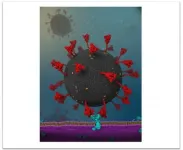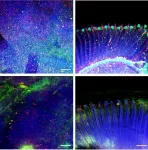(Press-News.org) Arctic habitats have fascinated biologists for centuries. Their species-poor insect faunas, however, provide little reward for entomologists - scientists who study insects - to justify spending several weeks or even months in the hostile environments of tundra or polar deserts. As a result, data on insects from the High Arctic islands are often based on occasional collecting and remain scarce.
Vize Island, located in the northern part of the Kara Sea, is one of the least studied islands of the Russian High Arctic in terms of its biota. Scientists Dr Maria V. Gavrilo of the Arctic and Antarctic Research Institute in Russia and Dr Igor I. Chupin of the Institute of Systematics and Ecology of Animals in Russia visited this ice-free lowland island in the summer of 2020.
"Our expedition studied the ecology of Ivory Gull", Maria Gavrilo says, "but we also looked for other wildlife." Because of the lack of data, scientists appreciate any observation on insects they can get from the High Arctic.
On the island, the team found hundreds of small moths. They were identified by Dr Mikhail V. Kozlov of the University of Turku, Finland, as Larch Budmoths - the first and only terrestrial invertebrate to ever be observed and collected on Vize Island. Their observations are published in the open-access, peer-reviewed journal Nota Lepidopterologica.
The scientists first observed live and freshly dead moths on the sandy banks of a pond near the meteorological station. Then, they saw hundreds of them at the sandy bottom of a river valley with shallow streams. Moths, single or in groups, were mostly found at the water's edge, along with some fine floating debris. Despite extremely low daily temperatures (+2-5°C), flying moths were also spotted on several occasions.
The larvae of Larch Budmoth feed on the needles of different coniferous trees. Because Vize Island is located 1000 km north of the tree limit, the scientists can be sure about the migratory origin of the moths observed on Vize Island. They were likely transported there on 12-14 July 2020 by strong winds coming from the continent. The nearest potential source population of Larch Budmoth is located in the northern part of the Krasnoyarsk Region, which means they travelled at least 1200 km.
Importantly, some moths remained alive and active for at least 20 days after their arrival, which means that long-distance travel did not critically deplete resources stored in their bodies. The current changes in climate are making it easier for more southerly insects to invade species-poor areas in the High Arctic islands - provided they can reach them and survive there.
"The successful arrival of a large number of live moths from continental Siberian forests to Vize Island has once more demonstrated the absence of insurmountable barriers to initial colonisation of High Arctic islands by forest insects", concludes Mikhail Kozlov, who has studied Arctic insects for decades. "The Arctic islands will be colonised by forest insects as soon as changing environmental conditions allow the establishment of local populations."
INFORMATION:
Original source:
Gavrilo MV, Chupin II, Kozlov MV (2021) Carried with the wind: mass occurrence of Zeiraphera griseana (Hübner, 1799) (Lepidoptera, Tortricidae) on Vize Island (Russian High Arctic). Nota Lepidopterologica 44: 91-97.
https://doi.org/10.3897/nl.44.63662
WATERLOO, Ontario, March 29, 2021--A newly-published paper represents one of the most comprehensive reviews of advancements to come in contact lenses, catapulting the commonly-used medical device to applications well beyond refractive error correction.
Contact Lens Technologies of the Future (Jones L, et al.) is now in press from Contact Lens and Anterior Eye, the peer review journal of the British Contact Lens Association (BCLA). It joins nine other papers being printed in next month's special edition as part of the BCLA-led Contact Lens Evidence-based Academic Reports (CLEAR) series.
"There are a range of ...
Bioengineering researchers at Lehigh University have identified a previously unknown interaction between receptors in human cells and the spike, or "S," protein of SARS-CoV-2, the virus that causes COVID-19. This new information could aid in the development of new strategies to block SARS-CoV-2 entry into human cells.
X. Frank Zhang and Wonpil Im knew from recent studies that the interaction between the SARS-CoV-2 spike protein and angiotensin-converting enzyme 2 (ACE2) receptors in human cells is stronger than the interaction between the structurally identical spike protein of SARS-CoV-1, the virus that caused the 2002-2004 SARS outbreak, and the same receptors.
"Our goal was to characterize SARS-CoV-2 ...
CHAMPAIGN, Ill. -- Monitoring the progression of multiple sclerosis-related gait issues can be challenging in adults over 50 years old, requiring a clinician to differentiate between problems related to MS and other age-related issues. To address this problem, researchers are integrating gait data and machine learning to advance the tools used to monitor and predict disease progression.
A new study of this approach led by University of Illinois Urbana Champaign graduate student Rachneet Kaur, kinesiology and community health professor Manuel Hernandez and industrial ...
United Methodist churches -- whether the congregation is white or not -- have higher attendance when located within white neighborhoods. But racial diversity within a church is associated with higher average attendance over time, according to a new study.
"This is a startling contrast to previous research that reported multiracial congregations are less stable," said lead author Kevin D. Dougherty, Ph.D., associate professor of sociology at Baylor University.
The study is published in the journal Social Forces.
Previous research has found that it is difficult for congregations to build and sustain racially diverse memberships, ...
A new study suggests that clearing the invasive woody weed Prosopis julifora and grassland restoration in Baringo County, Kenya, may have significant financial benefits for local stakeholders and contribute to climate change mitigation.
Climate change, land degradation, and invasive alien species (IAS) such as Prosopis julifora are major threats to people's livelihoods in arid and semi-arid areas with each of these having negative impacts on ecosystem services - including vegetation biomass, which is a prime resource for pastoralists and agro-pastoralists.
The team, comprising PhD students and established scientists from four countries and different ...
LOS ALAMOS, N.M., March 26, 2021--New research has demonstrated that a magnetic uranium compound can have strong thermoelectric properties, generating four times the transverse voltage from heat than the previous record in a cobalt-manganese-gallium compound. The result unlocks a new potential for the actinide elements at the bottom of the periodic table and point to a fresh direction in research on topological quantum materials.
"We found that the large spin-orbit coupling and strong electronic correlations in a system of uranium-cobalt-aluminum doped with ruthenium resulted in a colossal anomalous Nernst conductivity," said Filip Ronning, lead investigator on the paper published today in Science Advances. Ronning ...
Presents a brief overview of the eight COVID-19 editorials published in DMPHP over the past year and using them as a framework to follow the evolution of the Pandemic over time. A review of the salient epidemiological and clinical dimensions of COVID-19 over time is given as well as a discussion of the medical and public health impacts of the disease and the interventions and policies put in place to contain and mediate the virus.
The concluding discussion questions the validity of the criteria used in selection of priority groups for vaccination in the US and notes that had a uniform program supporting the immunization of all over age 65 (accounting for 80% ...
How do different parts of the body communicate? Scientists at St. Jude are studying how signals sent from skeletal muscle affect the brain.
The team studied fruit flies and cutting-edge brain cell models called organoids. They focused on the signals muscles send when stressed. The researchers found that stress signals rely on an enzyme called Amyrel amylase and its product, the disaccharide maltose.
The scientists showed that mimicking the stress signals can protect the brain and retina from aging. The signals work by preventing the buildup of misfolded protein aggregates. Findings suggest that tailoring this signaling may potentially help combat neurodegenerative conditions like age-related dementia and Alzheimer's disease.
"We found that a stress response ...
The Environmental Protection Agency (EPA) is underestimating methane emissions from oil and gas production in its annual Inventory of U.S. Greenhouse Gas Emissions and Sinks, according to new research from the Harvard John A. Paulson School of Engineering and Applied Sciences (SEAS). The research team found 90 percent higher emissions from oil production and 50 percent higher emissions for natural gas production than EPA estimated in its latest inventory.
The paper is published in the journal Atmospheric Chemistry and Physics.
The research team, led by Joannes Maasakkers, a former graduate student at SEAS, developed a method to trace and map ...
Australian researchers have discovered a new way to target an aggressive childhood cancer, neuroblastoma, one of the most common and dangerous cancers in young children.
The discovery may also have important implications for some other aggressive cancers in children, including certain brain tumours, as well as some adult cancers, including ovarian and prostate cancer.
The new research, led by scientists at Children's Cancer Institute and published in Nature Communications, has discovered that a cellular protein called ALYREF plays a crucial role in accelerating the effects of the cancer driver gene, MYCN, in neuroblastoma.
Scientists have known for some time that the one third of children with neuroblastoma who have ...






